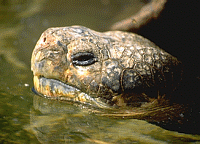





|
 Ecuador's Galàpagos Islands are famous for their unique and varied endemic wildlife. Of the many unusual creatures these isolated rocky islands feature, none are more characteristic than the Giant Tortoise, Geolchelone elephantopus. In fact, the name of the islands is based on the Spanish word for "saddle", a reference to a common name for these landlocked reptiles, "saddle-backed tortoises". The tortoises, weighing in at up to 250 kilograms (550 pounds), are indeed giants. Like many of their kin, they are long-lived, reaching sexual maturity at about 20 to 25 years, and living at least 150 years. But they are probably best known from the writings of Charles Darwin, whose interest was piqued by the claim of a local governor that each island had its own variety identifiable by the form of the carapace.
"I will describe the habits of the tortoise. Some grow to an immense size; the old males are the largest, the females rarely growing to so great a size: the male can be readily distinguished from the female by the greater length of its tail. They frequent in preference the high damp parts, but they likewise live in the lower and more arid districts.
The tortoise is very fond of water, drinking large quantities and wallowing in the mud. The larger islands alone possess springs, and these are always situated toward the central parts, and at a considerable height. The tortoises, therefore, which frequent the lower districts, when thirsty, are obliged to travel from a long distance. Hence broad and well-beaten paths branch off in every direction from the wells down to the sea-coast; and the Spaniards, by following them up, first discoverd the watering-places."
Today, scientists consider the varieties of these tortoises to be subspecies. It is believed that 250,000 individuals of fourteen subspecies inhabited these remote islands when they were first explored by sailors in the mid-sixteenth century. About 15,000 individuals survive today, and ten of the original subspecies retain viable populations. Conservationists are working hard to preserve them both in their native habitat and by captive breeding. |